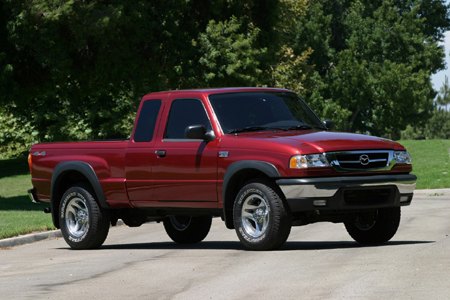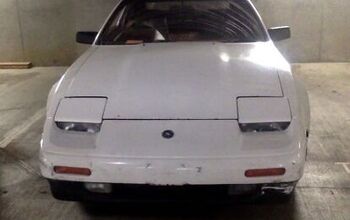Mazda B4000 Review
I'm good with names. Meet me at a party. Five hours and seven beers later, I'll cruise up and say, "Hey Benjamin, how goes it?" That’s assuming A) your name is Benjamin and B) you’re interesting. If a person is as dull as Tuesday afternoon C-Span, then the part of my brain that puts faces to names shuts down. I mention this because I had to click over to mazdausa.com to figure out if I’m driving the B4000 or B4400. Turns out it’s the former. Who knew?
Design-wise, Mazda usually does one of two things: nail it (Miata, Mazda3) or overcook it (RX-8, Speed6). The designers of the B-Series truck didn't even try. It’s a pastiche of truck clichés that shouts “cheap!” like a 3,915 pound canary. The B4000’s pinched front end and teeny grill are not only two-decades behind the truck-times, but they’re pug ugly. Three-spoke wheels have never and will never look good on any vehicle. On the B4000 they look fat, too. DCX may have copied the B4000’s chunky wheel arches for their new S-Class, but at least they had the good sense to round them out. A squared off half-circle says "accident survivor" to me.
Like Toyota 4Runners of yore, you enter the B4000 by climbing into a high-floored cabin– that forces you to sit with your legs sticking nearly straight out. In terms of quality, style and livability, the B4000’s interior is lower-rent than a Chernobyl apartment building. I'm not calling the Mazda’s seats the worst I've ever sat in, but that’s only because I’ve given Old Sparky a miss. More specifically, the chairs are less supportive than Hugo Chavez on America’s Iraq policy. While the rear “seats” are small and cramped enough to render the word useless useless, the quarter-sized doors are easy to open in tight quarters. The resulting space behind the front seat is perfect for lugging a bag of groceries or three.
Fake carbon fiber surrounds the B4000’s radio. Why would Mazda go for faux race car chic in a truck that’s less sporty than NBC’s smallest loser? The scalloped vents along the top of the dash are… bizarre. On the positive side, the B4000’s column-shifter frees-up the center console for more storage-nooks and holding-crannies than the Honda Ridgeline.
The B4000 is the best handling small truck on the road– if you transport yourself back to its 1994 debut. Twelve-years later, the truck is showing its age with less grace than Kathleen Turner. Rough roads make turning the wheel an impromptu low rider bounce clinic. Smooth pavement highlights the chassis’s other shortcomings. On the positive side, um, above 70mph you get a free hand massage from the vibrating steering wheel. And some might find the squeak in the steering column soothing.
For those of you with points on your license, getting Mazda’s truck to crest 80mph on anything other than an Olympic ski jump is very, very difficult. The 4.0-liter 12-valve V6 powerplant kicks out 207hp @ 5,250rpm and stumps up 238lbs. feet of torque @ 3,000rpm– well behind the power Toyota’s same-sized mill produces in the much newer Tacoma. The B4000’s speed sensitive rack and pinion power steering makes it easy to exploit whatever speed you generate. The ABS brakes shed it just as easily. And if you baby the B, it’ll travel 16 mpg in the city, 20 in the highway. If you drive it, you won’t.
Unlike the modern behemoths so bewildering to Japanese engineers everywhere, the B4000 has a low load in height. Case in point: I helped a friend haul a VW Karmann Ghia 1500 engine back from a machine shop. We were able to lift the two-hundred pound lump of magnesium and pig-iron out of the Mazda’s bed, no problem. While an F-150 can haul more in terms of weight, the B4000 comes standard with a 72-inch bed, to the F-150's 66-incher. For most people most of the time, the 4000 (and its clone, the Ford Ranger) makes a lot more sense than the full-sized trucks used by some of the people all of the time.
In fact, it’s too bad Mazda let the B4000 die on the vine. Gas prices may have dipped in the past few weeks, but the country’s automotive gestalt has shifted. Enormous and irresponsible is out; moderate and slightly less irresponsible is in. It’s the perfect time to release a small, efficient truck that’s about 80% as useful as the full-sized giants so many people are currently unloading (so to speak). But no, at a time when Honda’s Ridgeline has (almost) reignited and (just about) re-invented the light-truck market, FoMoCo is content to let another market segment fall entirely into the hands of Honda, Toyota and Nissan. While the B4000 has its supporters, it will eventually be remembered as a forgettable experience.
Latest Car Reviews
Read moreLatest Product Reviews
Read moreRecent Comments
- Jkross22 When I think about products that I buy that are of the highest quality or are of great value, I have no idea if they are made as a whole or in parts by unionized employees. As a customer, that's really all I care about. When I think about services I receive from unionized and non-unionized employees, it varies from C- to F levels of service. Will unionizing make the cars better or worse?
- Namesakeone I think it's the age old conundrum: Every company (or industry) wants every other one to pay its workers well; well-paid workers make great customers. But nobody wants to pay their own workers well; that would eat into profits. So instead of what Henry Ford (the first) did over a century ago, we will have a lot of companies copying Nike in the 1980s: third-world employees (with a few highly-paid celebrity athlete endorsers) selling overpriced products to upper-middle-class Americans (with a few urban street youths willing to literally kill for that product), until there are no more upper-middle-class Americans left.
- ToolGuy I was challenged by Tim's incisive opinion, but thankfully Jeff's multiple vanilla truisms have set me straight. Or something. 😉
- ChristianWimmer The body kit modifications ruined it for me.
- ToolGuy "I have my stance -- I won't prejudice the commentariat by sharing it."• Like Tim, I have my opinion and it is perfect and above reproach (as long as I keep it to myself). I would hate to share it with the world and risk having someone critique it. LOL.





































Comments
Join the conversation
Yes these trucks, the B-series and Ranger are outdated, but there seems to be a whole lot of them on the roads. They are dated and not as good as a Tacoma it's true, but the bottom line is price. You can get the basic regular cab 2 wheel drive version for about 12,000 Canadian brand new. My friend has a Tacoma and I have a B4000. What does his do much better than mine when it comes to a truck? I know he pays alot more for his lease each month than I do to buy mine. That's the bottom line for most people. I still think the B4000 looks good, and it's great around a city, very easy to park.
I just bought a used 1994 B4000 with 136,000 miles for $1,800. A $900 repair replaced a leaking head gasket and manual hubs for the 4WD. It has rained liked mad and I have a leak into the cab at the third break light above the rear sliding window. Other than that, I really like this little truck. The criticism above is pretty harsh, but probably accurate. My first MPG check showed 13 mpg, but I was driving pretty hard. It's a little gutless, but I hope to tinker with it a bit to get some more horsepower. I bought it to haul junk around the farm and get me to the hardware store and back. I'll post more when I have more time behind the wheel.